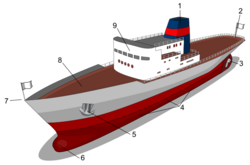Engineering:Afterdeck

Main parts of ship. 1: Funnel; 2: Stern; 3: Propeller and Rudder; 4: Portside (the right side is known as starboard); 5: Anchor; 6: Bulbous bow; 7: Bow; 8: Deck; 9: Superstructure
In naval architecture an afterdeck or after deck, or sometimes the aftdeck, aft deck or a-deck, is the open deck area toward the stern or aft back part of a ship or boat. The afterdeck can be used for a number of different purposes. Not all ships have an afterdeck. In place of the afterdeck a ship may be built with a poop deck, that is a deck that forms the roof of a cabin built in the rear, or "aft", part of the superstructure of a ship. A poop deck usually is higher up than an afterdeck. A ship may have its superstructure or aftercastle located in the stern and thus not have an afterdeck. The stern and afterdeck of a ship are usually more smooth and stable than the bow (front) of the ship in motion. A taffrail is the handrail around the open afterdeck or poop deck. On wooden sailing ships like man-of-war or East Indiaman the taffrail is usually a hand carved wood rail and often highly decorated.[1] [2][3][4] [5]
Afterdeck uses
- Navy war ships may use the afterdeck to mount deck guns.
- Missile boats may have missiles launching on the afterdeck.
- Minelaying gear on Navy ship's afterdeck.
- Minesweeper gear on Navy ship's afterdeck.
- Depth charge launching on Navy ship's afterdeck.
- Torpedo tube for torpedo launching on Navy ship's afterdeck.
- Some Navy and private ships use the afterdeck as a helicopter deck for a heliport for helicopters.
- A sundeck for chairs, chaise longue and lounge chairs.
- Rear deck swimming pool with a sundeck.
- On fishing boats a place to lay fishing nets or big-game fishing chairs or trawler gear.
- Cable laying gear.
- Scuba diving deck.
- Amphibious vehicle launching
- Submersible launching
- Water skiing launching
- Samson post, a strong pillar-post for a towing cable or other support.
- Lifting crane or gantry crane.
- Ferry ramp for vehicles.
- Ancient Greece ships sometimes had shrines or altars on the afterdeck.[6]
Gallery
-
HMNZS Canterbury with a large aftdeck for helicopters.
-
HMNZS Canterbury's helicopter afterdeck.
-
President Truman and members of his staff relaxing on the afterdeck of the yacht Engineering:USS Williamsburg.
-
After deck of Engineering:USS Manchester.
-
HO3S landing on after deck of Engineering:USS Manchester.
-
After deck of Abeille Bourbon.
-
Sailors on the afterdeck of HTMS Nakha.
-
Aftdeck pool on Golden Princess.
-
Missile boat with missile launching on the after deck.
-
After deck of a UK Rescue Lifeboat 17-31.
See also
- Common names for decks
- Main deck
References
- ↑ Getty Images, Taffrail Pictures and Images
- ↑ http://phrontistery.info, Nautical Terms
- ↑ Yachting, Dec. 2006 issue, page 94
- ↑ US Navy, LPD 17 Program Summary, Jan. 2017
- ↑ Marine Technology, Vol. 18, No. 1, Jan. 1981, pp. 38-50 Motion Studies of a Vessel with Water on Deck by Jeff Dillingham
- ↑ The Greek Age of Bronze Ships
 |










